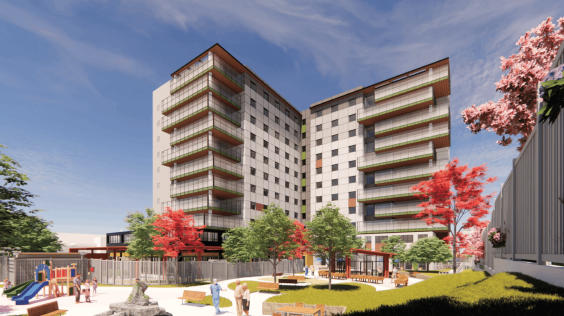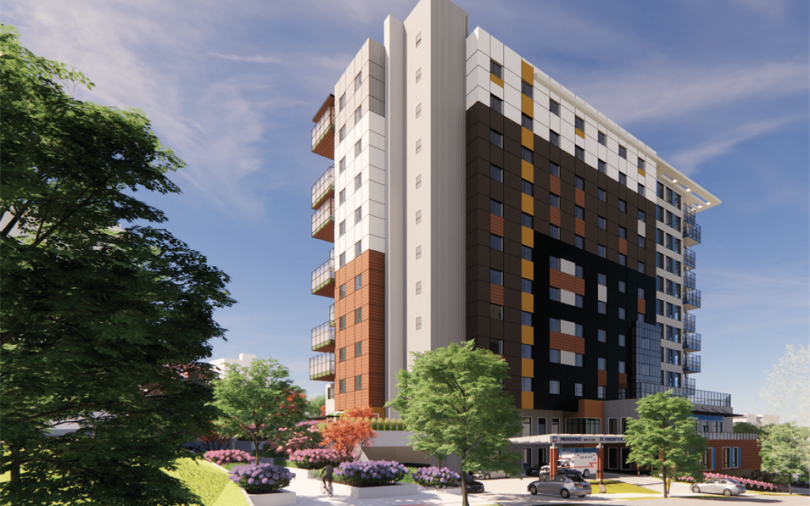The St. Vincent’s Heather project is charting a new course in sustainable health care practices. As the new 240-bed seniors care home development moves forward, a key aspect in the design planning is ensuring the most sustainable and energy-efficient development possible.
Setting the stage for sustainability
At Providence, we recognize the urgent need to address the challenges posed by climate change. Climate resilience practices are a priority for all our major capital projects, and the St. Vincent’s Heather project is no exception. Through meticulous planning and forward-thinking design, we’re incorporating climate-resilient features to safeguard the well-being of our staff and residents for generations to come. Our commitment to sustainability isn’t just a goal – it’s a guiding principle that shapes every aspect of our project.
Walking the talk
From energy-efficient design features to renewable energy solutions, we’re embracing innovative technologies and best practices from around the world to reduce our carbon footprint and set a new standard for health care facilities nationwide. The project team is embracing a net-zero-emissions approach by reducing greenhouse gas emissions by up to 93 per cent relative to the Vancouver Building Bylaw requirements of 85 per cent greenhouse gas reduction. Technologies such as air-source heat pumps and electric boilers make this goal achievable by helping to maintain comfortable indoor temperatures in the future, without compromising on operational efficiency.

All windows, roof insulation and walls are being investigated for enhanced thermal performance to reduce heat loss in the winter and overheating in the summer. The project continues to investigate incorporating new cutting-edge technologies that will save even more energy, all the while protecting residents and staff from viruses and bacteria, poor air quality from pollutants, and wildfire smoke events.
Maintaining and ensuring healthy indoor air quality
St. Vincent’s Heather will have a ventilation system that meets strict standards for health care facilities. There will be two main air handling units, one for the north wing and one for the south wing, with a backup in case one fails. These units will bring in fresh outdoor air while recycling indoor air, and have filters to clean the air, coils for heating and cooling, and fans for circulation. If one of the units breaks down, the other will pick up most of the airflow. The system can also switch to using all outdoor air in the event of an emergency, and the exhaust systems will remove air from washrooms and utility rooms to keep the building clean and safe for residents and staff.
Electrification: A shift towards sustainable energy
This home aims to be entirely electrified, meaning it runs wholly on electricity. This requires St. Vincent’s Heather to have a five-megawatt electrical capacity and three-megawatt emergency power. Two large generators will provide most of the power, with one acting as a backup in case of failure, ensuring continuous operations until an external generator arrives and is connected to the system. This electrification strategy diminishes dependence on fossil fuels, leading to lower greenhouse gas emissions and aligning with Providence’s sustainability goals. Moreover, BC electricity primarily comes from hydro-generation, making it a more environmentally friendly option compared to gas or coal-powered electricity sources.
Charting the course ahead
The new St. Vincent’s Heather long-term care home truly embraces a holistic approach to sustainability. In addition to sustainable building design, this home will embrace Providence Living’s standard for eco-friendly practices in every aspect of its operation. This includes thorough waste-management initiatives as well as water-conservation measures both during construction and in operation. Providence and UBC have collaborated to develop an organics digester to convert operational compost into a biofuel that can be used for either preheating or topping off domestic hot water.
This Earth Month, as we celebrate our wonderful planet and reflect on our commitment to excellence in health care, we acknowledge that our mission is only achievable when we also prioritize the health of our environment. Our primary goal has and always will be to provide excellent, high-quality health care to those we serve, both now and in the future, and we recognize that sustainability is fundamental to our success.
To learn more about the St. Vincent’s: Heather project, visit newsvh.providencehealthcare.org
By Emma Bousfield





